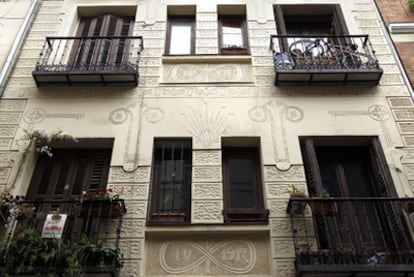The genital art of 'sgrafiato'
Art Nouveau architect dangles an intriguing question on Madrid façade
If you look closely at the façade of No. 12, Calle Montserrat in Madrid, you may do a double-take. But there they are. Firmly delineated in sgrafiato (a plaster technique) are six huge pendent penises, two to each story. Amid each pair is another design that seems to represent a vagina, though it is rather more abstract and might well be some kind of beetle. Feminine sexuality is complex, of course.
It is an ordinary house of apartments, otherwise quite unremarkable, in a narrow street just off Calle San Bernardo in downtown Madrid. The plaster parament also features horizontal sgrafiato stringcourses of what look like smaller sexual symbols, while rectangular compartments are filled with horizontal figure eights, like the infinity symbol, with a date inscribed: IV / 1912.
Asking the residents is fun, but not much use. Two elderly women who appear on balconies, on both sides of the street, are evasive. What do you think of the phallic decorations? "Very nice." "Cheerful." "Kind of abstract." A younger resident, who lived there for years before noticing the designs, admits that some locals call it Pecker House (it was a priest who told him this). He ventures a guess that it might have been a prison for women, or a house of prostitution, "because in antiquity, brothels had such symbols over the doors." But in ancient Rome an erect phallus symbol brought luck to any house, and Madrid brothels have never been advertised in this manner.
Nearby, in the old Conde Duque barracks, now a cultural center, an archive reveals that the architect was Arturo Pérez Merino, who built the house for Luis Navarrete, a promoter acting for a lady investor who wanted an apartment house for rental. The peniform designs appear on the plans, but none of the officials who signed them had anything to say about them. And it was on the way to this archive that the art historian Óscar da Rocha noticed the house.
"I flipped out," he says. "I had never seen anything like it." Da Rocha was writing a thesis on the Art Nouveau style in Madrid, and Pérez Merino was one of the architects mentioned in it. "He did half a dozen buildings in an eclectic Art Nouveau style, all of them down-market, lower-middle-class housing. Simple work, but adorned in an imaginative and personal style."
"He is an unknown architect. Very little data on him," adds Ricardo Muñoz Fajardo, co-author with Da Rocha of Madrid modernista. Guía de arquitectura, a guide to Art Nouveau architecture in Madrid. They have never found a photo of Merino, and as for personal data, only the date of his professional registration (1897) has surfaced. Muñoz Fajardo is thinking of including him in a novel set in that era.
Merino's works also include a house at No. 96 Calle Hortaleza, with curious brackets in the form of serpents, and one at No. 4 Calle Don Pedro, (birthplace of the actress Lina Morgan, a plaque explains), where a dragon curls over the lintel around the architect's name.
"Merino always puts in some little oddity," says Da Rocha. "I like his extravagance. The eclecticism of the day gave you a certain freedom, but did not encourage imagination. Most architects just copied from pattern books: a bit of this, a bit of that. Merino, even working on fairly humble buildings, invented things, departed from routine."
Masonic symbols? Freudian inspiration? Esoteric visions brought on by indulgence in fin-de-siècle absinthe? What does it all mean? "I think it's a joke," says Da Rocha. "In Madrid the Art Nouveau movement was frowned upon. It was called aberrant and irrational. Official taste was conservative. Perhaps Merino was laughing at the conservatives. But we don't really know." An answer to the penis question is still pending.

Tu suscripción se está usando en otro dispositivo
¿Quieres añadir otro usuario a tu suscripción?
Si continúas leyendo en este dispositivo, no se podrá leer en el otro.
FlechaTu suscripción se está usando en otro dispositivo y solo puedes acceder a EL PAÍS desde un dispositivo a la vez.
Si quieres compartir tu cuenta, cambia tu suscripción a la modalidad Premium, así podrás añadir otro usuario. Cada uno accederá con su propia cuenta de email, lo que os permitirá personalizar vuestra experiencia en EL PAÍS.
¿Tienes una suscripción de empresa? Accede aquí para contratar más cuentas.
En el caso de no saber quién está usando tu cuenta, te recomendamos cambiar tu contraseña aquí.
Si decides continuar compartiendo tu cuenta, este mensaje se mostrará en tu dispositivo y en el de la otra persona que está usando tu cuenta de forma indefinida, afectando a tu experiencia de lectura. Puedes consultar aquí los términos y condiciones de la suscripción digital.
Últimas noticias
The complicated life of Francesca Albanese: A rising figure in Italy but barred from every bank by Trump’s sanctions
Reinhard Genzel, Nobel laureate in physics: ‘One-minute videos will never give you the truth’
Pinochet’s victims grapple with José Antonio Kast’s rise in Chile
How Japan is trying to avert ‘digital defeat’
Most viewed
- Why we lost the habit of sleeping in two segments and how that changed our sense of time
- Pablo Escobar’s hippos: A serious environmental problem, 40 years on
- Trump’s obsession with putting his name on everything is unprecedented in the United States
- The Florida Keys tourist paradise is besieged by immigration agents: ‘We’ve never seen anything like this’
- Charles Dubouloz, mountaineering star, retires at 36 with a farewell tour inspired by Walter Bonatti








































